-
March 17, 2020 by Total Fire and Safety

By now, most Americans are aware that you cannot contract the Coronavirus by drinking a Corona beer! We also know that the Coronavirus outbreak, that began in Wuhan, China, has spread across 27 countries including the United States. It is estimated that over 87,000 people are infected with the coronavirus or COVID-19 and numbers continue to climb. Much is unknown about the virus that causes COVID-19, but Doctors and scientists are drawing knowledge from similar coronaviruses and are working on a vaccine. What is the coronavirus and how can you as a business, keep employees healthy?
What is the Coronavirus(COVID-19)?
According to the CDC (Center for Disease Control), Coronaviruses are a large family of viruses that are common in humans and many different species of animals, including camels, cattle, cats, and bats. The virus that causes COVID-19 is spreading from human to human and causes with respiratory infections, like the common cold. The infection can become severe when it turns into pneumonia. One of the challenges to this virus is that symptoms may not show for two weeks, making it easy to spread.
What Can Employers do to Keep Employees Healthy?
The following is the CDC’s recommendation for businesses to create a healthy work environment.
1. Encourage sick employees to stay home. Employees should be fever free for 24 hours without the use of fever reducing medication. Stay flexible when it comes to sick leave, i.e., not requiring a healthcare provider note to stay off work. Provide job security and/or remote access when/if they need to stay home.
2. Encourage clean hands. Provide touch-free sanitizer dispensers, cleansing wipes, soap and water etc. Place informational posters throughout the workplace that encourage healthy precautions. Instruct employees to use hand sanitizers or wash hands with soap for at minimum 20 seconds.
3. Enforce Coughing Etiquette. Emphasize the need to cover mouths with arm when coughing or sneezing.
4. Quarantine sick employees. If employees come to work sick or become ill while at work, separate them from the rest of the population and send them home.
5. Sanitize touch points daily. Routinely clean doorknobs, buttons, switches, handles etc.(Any area frequently touched). Have readily available disposable wipes near commonly used surfaces.
6. Stress caution to employees traveling in or outside the country. If employees become ill while traveling, advise them to contact a healthcare provider immediately. Employees who show symptoms of illness prior to traveling should stay home.
A first aid kit can help!
A first aid kit should always be on hand for any business, but with a new virus in town, its value is even greater. Basic first aid kits contain items like pain relievers and fever reducers, antacids, and bandages to keep employees comfortable and on the job. Other items in a typical OSHA-required first aid kit can also come in handy to help employees fend off coronavirus:
Wound cleaning agents such as sealed moistened towelettes can be used to disinfect surfaces.
Latex gloves can come in handy to touch necessary items that may be infected
Resuscitation equipment such as resuscitation bag, airway, or pocket mask
Meanwhile, those with symptoms can make good use of other OTC supplies: Aspirin, Ibuprofen, Acetaminophen and Decongestants
Total Fire and Safety can assist your business in preparing for the coronavirus or any other emergency that may occur by servicing your first aid kit. Together we can fight this epidemic and keep one another healthy Give Total Fire and Safety a call today! (630)960-0560.
Category: Business Safety, Client Events, First Aid, First Aid Kits, Health and Safety Tags: commercial first aid kit, fire and safety needs, first aid, first aid supplies, lifesafety | Comments Off on Can You Protect Employees from the Coronavirus?
-
November 12, 2019 by Total Fire and Safety
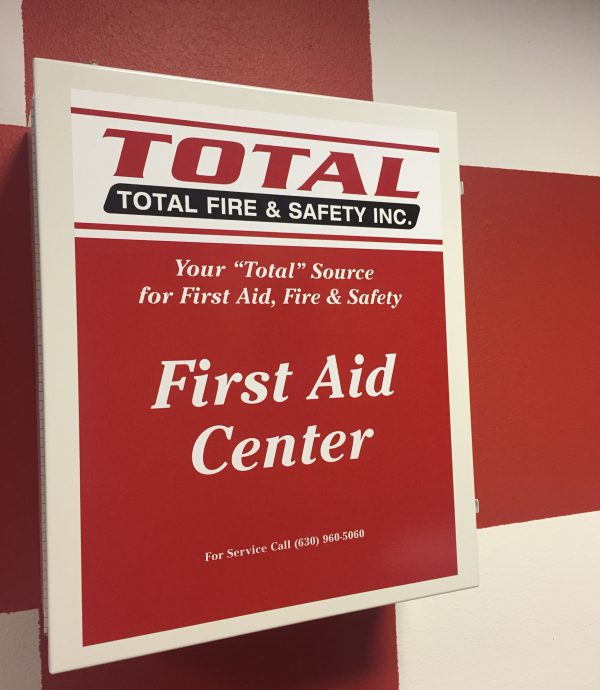
Does your organization have a first aid kit hanging on the wall? It sits there silently like a dutiful soldier, ready and waiting for any emergency. But with winter on its way, you may be surprised at how often that first aid kit can be called into service during the coldest months of the year.
Winter weather can easily compromise employee safety, whether the workplace is outdoors or in an office. It is important to keep first aid kits well stocked with winter safety essentials. Before you start planning your holiday office party, let’s look at your first aid kit and what we can do to “winterize” it.
OSHA has established a list of required first aid supplies for the workplace. Depending on the business and specifics of the environment, there are different first aid requirements. Employers are responsible for keeping the first aid kit stocked and up to date with the necessary supplies needed. They include:
- Band-aids, Elastic Bandages/Adhesive Tape, Sterile Gauze Pads/Rolls and Large Pressure Bandages in different shapes and sizes of bandages for possible falls, cuts, and scrapes. The opening of cracked, chapped winter skin can precipitate the need for a band-aid or a fall on the ice can merit more serious first aid treatment.
- Non-Latex Gloves, Antiseptic wipes, Peroxide and Alcohol and Triple Antibiotic Ointment will help keep those helping tend a wound safe, and also help the wound heal more quickly. Protect skin from contamination.
- Eye Pads and Eye Wash can help tend weather-related discomforts on the way into work.
- Tongue Depressors can be used to check throat irritations during winter flu season or be used as splints for possible weather-related injuries.
- CPR Shields can protect users from bodily fluids when CPR is essential. In winter, shoveling and overexertion in the cold can lead to cardiac arrest and the need for onsite CPR. Total Fire & Safety can help with employee training in this area.
- Triangular Bandages can be onsite in the event of the need for a sling or tourniquet. Falls on ice or minor accidents may require such dressings.
- Cold Packs: Instant cold packs help with sprains, fractures, burns, etc.… common injuries associated with falls, accidents, or overheating.
- Thermometer: Determines body temperatures. The flu and other winter maladies can be contagious! Detecting an above normal temperature in an employee can prevent an outbreak that can take down a workplace.
- Aspirin, Tylenol, or Motrin can help alleviate the symptoms of a cold.
- Penlight can be used to look in ears and throats for maladies, or even pupils for possible concussion victims.
- Antihistamine Tablets and Hydrocortisone to quell the allergies and dermatitis from the dry air, increased dust, and lack of fresh air during the winter months.
- Blankets to use in emergencies, such as frostbite, hypothermia, etc.
For any company, the first aid kit can be your first offense against the common winter injuries that employees can suffer en route or while at work:
Sprains and Broken Bones
Ice covered roadways, sidewalks, parking lots, and driveways put you at risk for a nasty fall which can result in a sprain or broken bone. If the injury is minor and does not require an immediate doctor’s care, delve into your first aid kit and treat the injury with RICE:
1. Rest the injured limb with crutches, a sling, or splint, or anything you can to keep from putting stress on it.
2. Ice the injured limb. Apply a cold pack to the area to prevent swelling.
3. Compress the injury by wrapping a bandage around it or use a sleeve.
4. Elevate the injured limb above the heart to reduce swelling.
In addition, offer the victim Tylenol, Aspirin, or Motrin for pain and swelling.
Frostbite
Frostbite occurs when skin cells and tissues freeze, damaging the skin walls. Most often it happens to fingers, toes, noses, cheeks, chin, ears, and the areas with most exposed skin. If frost bite should happen, remove the victim from the cold. Warm their hands by tucking them under the armpits. Cover the nose, ears, and face and remove any wet clothing. Once in warm shelter, place frostbitten areas under warm, not hot, water. Avoid direct heat. Treat pain with Tylenol, Aspirin, or Motrin from your first aid kit. If blisters or numbness continues, seek medical attention.
Hypothermia
Hypothermia happens when the body’s internal temperature drops below 95 degrees. Call 911 immediately. A person’s breath can become shallow or they can stop breathing all together. If this happens, CPR must be administered using a CPR shield from your first aid kit. If CPR is not necessary, get the person away from the cold and wrap them in a blanket, also in your first aid kit. Apply a warm compress to the chest, neck, groin, and head.
Winter weather can be dangerous and serious injuries can occur, beyond what a first aid kit is capable to handle. Assess the situation and call 911, if needed, first.
Total Fire and Safety can help you keep your first aid kits stocked appropriately and provide on-site first aid training for employees. Be prepared for winter! Give us a call today! (630)960-5060.
Category: Business Safety Tags: commercial fire protection, commercial fire safety, fire and safety solutions, first aid, first aid supplies, Total Fire & Safety | Comments Off on Fighting Winter Ills with the Company First Aid Kit
-
January 23, 2019 by Total Fire and Safety

Commercial first aid kits don’t have to be costly. Yet, when you start to compare commercial first aid providers, you will see some radical differences in pricing. Many first aid service companies find creative ways to drive up costs for their customers. At Total Fire & Safety, our customers never have to worry about “hidden costs” because there are none! Knowing what your company needs and being sure you are not paying for more can help your overall first aid budget and ensure you have the right first aid provider on your side. Here are some tips on hidden fees so you can avoid any surprise charges from your first aid service company.
- Make sure you know what is going in the box.
It is possible that you don’t need many of the supplies the service stocks in your cabinet. Depending on your workplace, employees can experience minor cuts etc. However, overstuffing a kit with odd size bandages and unnecessary items like hand lotion, lip ointment, dental cream, etc. helps a company justify a higher invoice. At Total Fire and Safety we stock what is required by OSHA and what is directed by the client. No redundant or unnecessary items.
- Make sure you are not getting charged extra for “normal” items.
Some companies charge extra for special items, like disinfectant wipes. Check your invoices! There are no surprises with TFS.
- Make sure you are not getting charged for additional representatives.
Some first aid companies have separate reps for stations, for example, first aid kits and eyewash stations. At TFS, your single representative is knowledgeable about all your first aid needs to streamline costs and deliver consistent quality service.
- Make sure the first aid service meets ANSI requirements.
ANSI (American National Standards Institute) puts together the requirements for first aid supplies in the workplace. They provide a specific list for first aid kits. A service company might overlook this list in order to stock a kit with many unnecessary various types of items. At Total Fire and Safety, we provide supplies required by ANSI as well as OSHA.
- Make sure you understand the fees on the invoice.
Do you see service or delivery charges, overstocking or restocking fees? First aid service companies pile these costs into an unreadable invoice. TFS does not charge service fees, fuel, or delivery charges. We only charge for items that employees have used. Have a question about the bill? TFS is there to answer any concerns.
There are many services companies in business to make a buck at the expense and well-being of your company. You should not have to choose between a safe work environment and a cheaper bill. TFS recognizes the importance of a healthy workplace combined with the affordability of superior service. TFS never overcharges, overstuffs, or places hidden fees with in a first aid kit. We provide the right supplies to keep employees safe at work while always keeping costs down. For more than 30 years, Total Fire and Safety has been providing OSHA approved first aid kits and replenishment to businesses. If we can help with your first aid needs, contact us today at 630-960-5060.
Category: Business Safety, First Aid, First Aid Kits, Total Fire and Safety Tags: fire and safety needs, fire safety, first aid, first aid supplies, Total Fire & Safety | Comments Off on Avoiding the Hidden Costs of Commercial First Aid Kits
-
December 19, 2017 by Total Fire and Safety
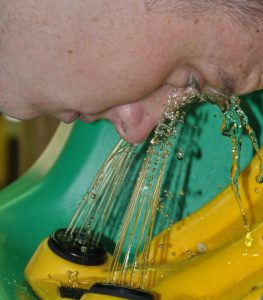 If you have hazardous chemicals onsite, you likely need an emergency eyewash station. One of the many vital services we provide at Total Fire and Safety is performing inspections on emergency showers and eye wash stations. Like any fire or safety equipment, routine inspections are a must to ensure your equipment will perform perfectly at a moment’s notice. In an emergency situation, nobody has the time troubleshoot an underperforming piece of equipment, let alone attempt to repair it. We’ve outlined the steps we take to ensure your eye wash station or emergency shower is ready in an emergency:
1. Ensure everything about the station’s location is correct. We first make sure the station is in an area it is needed. A working emergency eye wash station is of no use if it is not accessible to those who may need it. While showers tend to be fixed structures, eye wash stations can be either fixed or mobile. We also make sure the station is unobstructed and away from any source of debris or hazardous spray, which could compromise its usefulness.
2. Next, we inspect the exterior. We visually check every part of the station for any signs of damage, such as leaks, cracks, or other signs. Then, we check that all the hardware is intact and correctly in place, such as the caps, valves, and pull rods for showers. We then verify everything is at the correct height and that all signage is in its proper place before moving on to the next step.
3. After the visual inspection, we test the operation. For every eye wash station, we check the flow of water by gauging its height, volume, and response time from the moment of activation. For showers, we verify the water flows properly and onto the correct area.
4. For portable units, we empty and replace the water. This is to ensure the water in the reservoir is not only full, but clean and fresh. This step is also taken so that we can rinse out the inside as well as check for foreign debris or contaminants which could compromise the integrity of the eye wash station.
5. Finally, we clean everything and document the inspection. This entails wiping everything down with a rag and cleaning solution. Once this is done, we apply the inspection tag to the station to communicate to others when the inspection took place and what was performed. We also keep our own records of the inspection by filling out detailed information in an eyewash report.
In any facility that may contain hazardous substances, you may find an emergency shower or eye wash station idly waiting until needed. These units are not given much thought, but anyone who has ever used one in an emergency situation will vouch for its importance to stay in proper working order. If you have any questions or concerns about your emergency eye wash station or shower, or about the readiness of any of your fire safety equipment, please contact us.
Category: First Aid, Health and Safety, NFPA Compliance, Total Fire and Safety, Uncategorized Tags: fire and safety equipment, first aid, first aid supplies, Health and Safety, Total Fire & Safety | Comments Off on Are Your Emergency Eye Wash Stations Ready for Action?
-
April 19, 2017 by Total Fire and Safety
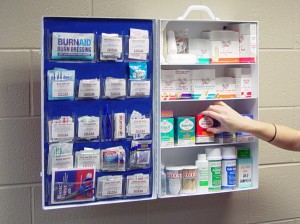
We cannot overstate the importance of first aid requirement for the workplace. If you read through the OSHA requirements for first aid kits and first aid training, and the ANSI minimum first aid equipment for businesses, you may notice that a lot of the details are left up to the business owner. That is because every business is different, and will have different risks depending on the equipment involved in the business. A simple office space might have a small, basic first aid kit, while a car mechanic would probably need a much more complex one. Here are five steps to help guide you through the process of determining what first aid kit and training your business and your employees need.
1. What are the most common injuries in your industry? Think about the equipment involved with your industry, and what kind of accidents can happen with that equipment. Make sure you satisfy the first aid requirement for workplace accidents to handle the most probable injuries within your specific business.
3. How close are you to the nearest hospital or medical center? In the event of an emergency, how long would it be until help arrived? If your business is in a remote location, you might need extra first aid materials to handle an emergency for a longer length of time.
4. How many employees do you have? Make sure there are enough first aid kits to handle an emergency where multiple people are injured. The more employees you have, the more first aid kits you should have.
5. Consider the layout of your workplace. Make first aid kits easy to get to, and easy to see. They must be clearly labeled, and all employees should know where they are. Also make sure that the first aid kits are accessible in the areas which are most prone to accidents, such as the kitchen in a restaurant.
There are a lot of options for both first aid kits and training. Make sure to think about restocking first aid kits and offering training to new employees. First aid requirements for workplace accidents can include portable kits or wall mounted kits, designed for indoor or outdoor use. For first aid training programs, make sure you go with a quality program that will teach your employees how to handle emergencies that are most likely to occur in your workplace. Cover the basics, and go beyond, to keep your employees healthy and safe.
If you have questions or concerns about first aid kit or training compliance, Total Fire and Safety is you one-stop source for all fire safety and first aid needs. Feel free to contact us at 630-960-5060.
Category: Uncategorized Tags: commerical first aid, commerical first aid kit, fire and safety equipment, fire and safety needs, fire safety, first aid, first aid kit, first aid safety, first aid supplies, safety, Total Fire & Safety | Comments Off on Five Questions to Ask to Assess Your First Aid Requirement for Workplace
-
February 21, 2015 by Total Fire and Safety
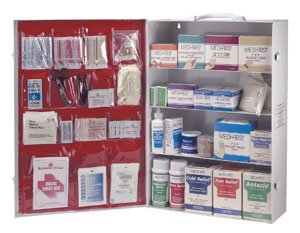
If one of your employees hurt themselves right now, do you have a commercial first aid kit for them to use? Is it fully stocked?
It’s not only important to have an OSHA-approved first aid kit onsite, but it’s also important to have the right kind, with the right contents, and have it replenished with first aid kit supplies on a regular basis.
Without a doubt, the number one reason you need to have a commercial first aid kit onsite is:
1. It’s Code!
OSHA’s “Fundamentals of a Workplace First-Aid Program”, publication states:
“It is advisable for the employer to give a specific person the responsibility
for choosing the types and amounts of first-aid supplies and
for maintaining these supplies. The supplies must be adequate,
should reflect the kinds of injuries that occur, and must be stored in
an area where they are readily available for emergency access.”
Under the ANSI standard, Z308.1-2009, businesses can maintain four different categories of first aid kits for general indoor use, office use and light manufacturing. Kits must also meet the performance and testing requirements set by the standard.
Type I: Kits for indoor use, intended to be in a fixed position, not portable, like a mounted wall cabinet for offices or manufacturing facilities.
Type II: Portable, indoor kits with a carrying handle to be used in office or manufacturing environments.
Type III: Portable kits for mobile indoor/outdoor settings that should have the ability to be mounted and are typical for transportation or construction jobs.
Type IV: Portable kits for rugged, environmentally hostile outdoor applications where potential for damage to the kit is high.
The ANSI standard details items needed for each kit but they generally include a selection of compresses, bandages, tape, gloves, antiseptic and burn treatments. Businesses with specific workplace hazards should consult with a competent healthcare professional to see what first aid kit supplies they should have. Depending on the workplace conditions, additional supplies may include eyewash, cold packs, eye covers, burn dressings, etc. The standard also addresses requirement marking and labeling of first aid kit supplies and the importance of having the commercial first aid kit regularly maintained, which can be tricky unless you retain a first aid supplier to do it.
2. Accidents Really DO Happen.
According to information from the National Institute for Occupational Health and Safety (NIOSH), an estimated 3.8 million workers in private industry and state and local government had a nonfatal occupational accident in 2012. The year prior, an estimated 2.9 million workers went to the ER with an occupational injury or illness and approximately 150,000 of those workers were hospitalized. In the doctor’s office or even a court of law, it’s important for your employee to be able to report that a first aid kit was available and well-stocked, but the injury’s severity required additional medical attention. Undoubtedly, at some time during their tenure with your business, every employee will have interaction with the kit at least once.
3. You Care.
Really, having a commercial first aid kit there for your employee’s comfort does send a message that workplace safety is important, as is the well-being of each employee. Employees who are more comfortable, are happier and therefore work more efficiently.
4. Productivity.
In some cases, a minor scrape, or headache can send an employee home to get the proper first aid for their ailment. Their departure, even for a short period of time, means others have to take their place, and the domino effect can wreak havoc on productivity. Worse yet, the employee may choose to take the rest of the day off. Having the first aid supplies they need on hand can keep an employee comfortably on the job.
5. Saved Time.
When an incident happens, nobody has to run out to the drug store for bandaids; they just reach inside the kit and find everything they need. Again, the first aid kit can keep everyone on the job where they belong and your productivity at the level you require.
At Total Fire & Safety, we are experts with OSHA approved first aid kits and have been offering first aid kit supplies and replenishment for more than 20 years. If you have any questions about the type of first aid kit you need for your business, call us today at 630-960-5060.
Category: First Aid Kits Tags: commercial first aid, first aid, first aid supplies, lifesafety | Comments Off on Five Reasons You Need a Commercial First Aid Kit
-
May 21, 2014 by Total Fire and Safety
Total Fire & Safety is welcoming some new additions to our website, including the “Wireless Fire Alarm Monitoring” page!
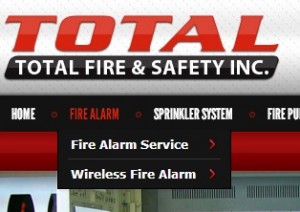
More and more municipalities, particularly in Chicagoland, are looking to reduce costs and increase efficiency by mandating wireless fire alarm systems for the businesses in their service area. Wireless fire alarm monitoring is faster, safer, and more reliable than phone- based systems that can fail from environmental factors. Also, with wireless fire alarm systems, businesses can disconnect their unneeded landlines and realize a substantial monthly savings.
Our new page includes information about Vigilant™ fire alarm monitoring equipment, which is our preferred manufacturer of fire safety equipment. Vigilant is an industry leader known for its affordable, yet high-quality products that easily retrofit in single-unit facilities or multi-story office buildings.
We’ve also added new icons on our home page to signify three growing and very important parts of our business—life safety training, first aid supplies and emergency lighting.
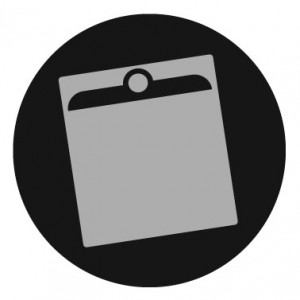
A new icon on our home page indicates our established life safety code training service which prepares employees for fire scenarios and teaches them the correct use of fire safety equipment. For businesses where fire prevention is a priority, these classes prepare employees with the information they need to keep themselves, their co-workers, and the facility safe. Classes are held at your location in a classroom setting with a hands-on, live burn session so employees get firsthand experience in extinguishing a fire. Other classes we offer include: hood suppression systems, paint booth suppression systems, proper evacuation procedures, fire sprinkler systems proper apparatus usage and more.
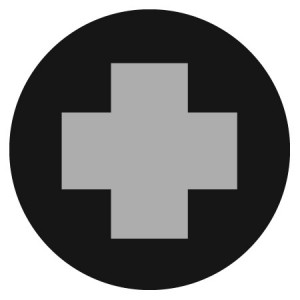
Everyone knows the red cross means safety, and the recently added icon represents our first aid supplies. Our service protects your employees with stocked cabinets of quality first aid supplies that we routinely replenish. When a minor injury occurs, your business is prepared, with the the right supplies on hand. We make the program affordable by only charging for the products your employees use. Our service helps businesses meet OSHA Regulation CFR 1910.151 (b).
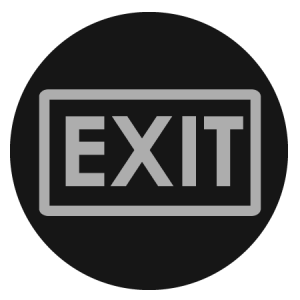
Our third new home page icon is the exit sign, which represents our emergency lighting and LED emergency lighting, including signs and combination exit sign and lighting units. We keep your emergency lighting in working order with regular inspections to ensure that all units are in compliance, mounted correctly and free of damage, with batteries charged and bulbs in proper working order. We are also specialists in helping companies convert their emergency signage from conventional light bulbs to LEDs, which has helped many of our clients reduce their service and supply cost.
We regularly provide free evaluations of your existing systems and can make recommendations on how to reduce costs for your company. For more information on our quality products and services, or to schedule an evaluation of your site, visit us at totalfireandsafety.com or call us at 630-960-5060.
Category: Fire Alarm Monitoring, Total Fire and Safety Tags: emergency lighting, fire and safety equipment, fire and safety needs, first aid supplies, life safety training, lifesafety, wireless fire alarm monitoring, wireless fire alarms, wireless fire alarms for business | Comments Off on Announcing….Our New Wireless Fire Alarm Monitoring Page!
|

|
|
|
|
|
|

 Facebook
Facebook
 Instagram
Instagram
 LinkedIn
LinkedIn









